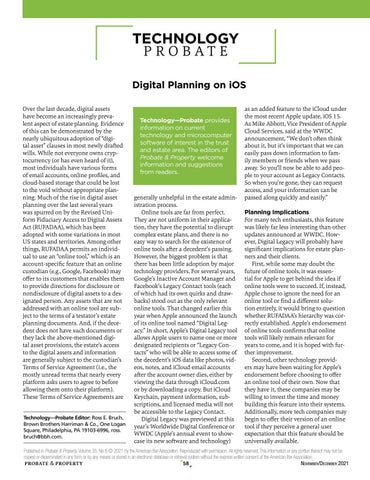TECHNOLOGY P R O B AT E Digital Planning on iOS Over the last decade, digital assets have become an increasingly prevalent aspect of estate planning. Evidence of this can be demonstrated by the nearly ubiquitous adoption of “digital asset” clauses in most newly drafted wills. While not everyone owns cryptocurrency (or has even heard of it), most individuals have various forms of email accounts, online profiles, and cloud-based storage that could be lost to the void without appropriate planning. Much of the rise in digital asset planning over the last several years was spurred on by the Revised Uniform Fiduciary Access to Digital Assets Act (RUFADAA), which has been adopted with some variations in most US states and territories. Among other things, RUFADAA permits an individual to use an “online tool,” which is an account-specific feature that an online custodian (e.g., Google, Facebook) may offer to its customers that enables them to provide directions for disclosure or nondisclosure of digital assets to a designated person. Any assets that are not addressed with an online tool are subject to the terms of a testator’s estate planning documents. And, if the decedent does not have such documents or they lack the above-mentioned digital asset provisions, the estate’s access to the digital assets and information are generally subject to the custodian’s Terms of Service Agreement (i.e., the mostly unread terms that nearly every platform asks users to agree to before allowing them onto their platform). These Terms of Service Agreements are Technology—Probate Editor: Ross E. Bruch, Brown Brothers Harriman & Co., One Logan Square, Philadelphia, PA 19103-6996, ross. bruch@bbh.com.
Technology—Probate provides information on current technology and microcomputer software of interest in the trust and estate area. The editors of Probate & Property welcome information and suggestions from readers.
generally unhelpful in the estate administration process. Online tools are far from perfect. They are not uniform in their application, they have the potential to disrupt complex estate plans, and there is no easy way to search for the existence of online tools after a decedent’s passing. However, the biggest problem is that there has been little adoption by major technology providers. For several years, Google’s Inactive Account Manager and Facebook’s Legacy Contact tools (each of which had its own quirks and drawbacks) stood out as the only relevant online tools. That changed earlier this year when Apple announced the launch of its online tool named “Digital Legacy.” In short, Apple’s Digital Legacy tool allows Apple users to name one or more designated recipients or “Legacy Contacts” who will be able to access some of the decedent’s iOS data like photos, videos, notes, and iCloud email accounts after the account owner dies, either by viewing the data through iCloud.com or by downloading a copy. But iCloud Keychain, payment information, subscriptions, and licensed media will not be accessible to the Legacy Contact. Digital Legacy was previewed at this year’s Worldwide Digital Conference or WWDC (Apple’s annual event to showcase its new software and technology)
as an added feature to the iCloud under the most recent Apple update, iOS 15. As Mike Abbott, Vice President of Apple Cloud Services, said at the WWDC announcement, “We don’t often think about it, but it’s important that we can easily pass down information to family members or friends when we pass away. So you’ll now be able to add people to your account as Legacy Contacts. So when you’re gone, they can request access, and your information can be passed along quickly and easily.” Planning Implications For many tech enthusiasts, this feature was likely far less interesting than other updates announced at WWDC. However, Digital Legacy will probably have significant implications for estate planners and their clients. First, while some may doubt the future of online tools, it was essential for Apple to get behind the idea if online tools were to succeed. If, instead, Apple chose to ignore the need for an online tool or find a different solution entirely, it would bring to question whether RUFADAA’s hierarchy was correctly established. Apple’s endorsement of online tools confirms that online tools will likely remain relevant for years to come, and it is hoped with further improvement. Second, other technology providers may have been waiting for Apple’s endorsement before choosing to offer an online tool of their own. Now that they have it, these companies may be willing to invest the time and money building this feature into their systems. Additionally, more tech companies may begin to offer their version of an online tool if they perceive a general user expectation that this feature should be universally available.
Published in Probate & Property, Volume 35, No 6 © 2021 by the American Bar Association. Reproduced with permission. All rights reserved. This information or any portion thereof may not be copied or disseminated in any form or by any means or stored in an electronic database or retrieval system without the express written consent of the American Bar Association.
58
November/December 2021










